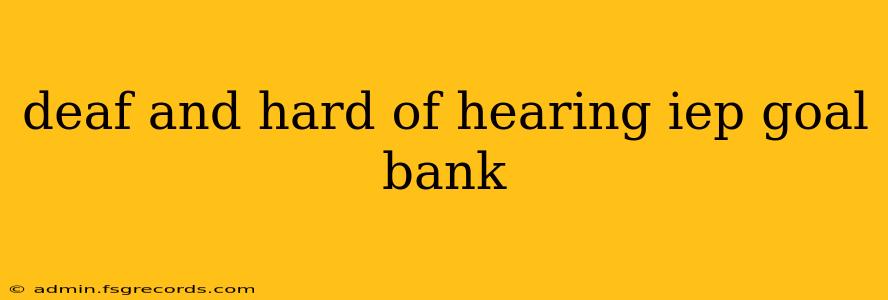Creating effective Individualized Education Programs (IEPs) for deaf and hard of hearing (DHH) students requires careful consideration of their unique communication needs and learning styles. This IEP goal bank offers a range of examples categorized by key areas, providing a starting point for developing measurable and achievable goals. Remember to always tailor these goals to the specific needs and abilities of the individual student. Collaboration with audiologists, speech-language pathologists, and the student's family is crucial for creating an effective IEP.
Communication Goals
This section focuses on improving the student's ability to receive and express information effectively.
Auditory Skills:
- Goal: [Student's Name] will improve auditory discrimination skills by correctly identifying 8 out of 10 spoken single words presented at 40dB HL in quiet conditions by [date].
- Goal: [Student's Name] will demonstrate improved sound localization by correctly identifying the direction of a sound source 4 out of 5 trials in a classroom setting by [date].
- Goal: [Student's Name] will increase their ability to understand speech in noise by correctly answering 9 out of 10 questions in a simulated classroom environment with background noise at 50 dB SPL by [date].
Speech and Language Development:
- Goal: [Student's Name] will increase vocabulary related to [specific topic] by 20 words, as measured by a receptive vocabulary test, by [date].
- Goal: [Student's Name] will improve articulation of [specific sounds] by producing them correctly in 90% of conversational speech, as judged by a speech-language pathologist, by [date].
- Goal: [Student's Name] will improve their ability to use complex grammatical structures (e.g., relative clauses, passive voice) in spoken and written communication by [date], as demonstrated through classroom assignments and informal conversations.
- Goal: [Student's Name] will improve their fluency in sign language by accurately signing [number] vocabulary words and phrases during conversational interactions, as judged by a qualified interpreter by [date].
Reading and Writing:
- Goal: [Student's Name] will increase reading comprehension by scoring at least [score] on standardized reading assessments by [date].
- Goal: [Student's Name] will improve written expression skills by writing a coherent paragraph containing a minimum of [number] sentences with correct grammar and punctuation on [topic] by [date].
- Goal: [Student's Name] will demonstrate improved reading fluency by reading [number] words per minute with [percentage]% accuracy by [date].
Academic Goals
These goals aim to ensure the student achieves academic success in various subject areas.
- Goal: [Student's Name] will demonstrate mastery of [specific math concept] by achieving a score of [score] on classroom assessments by [date].
- Goal: [Student's Name] will improve science comprehension by correctly answering [percentage]% of questions on science assessments related to [topic] by [date].
- Goal: [Student's Name] will participate actively in class discussions and activities by contributing [number] relevant comments or questions per class period by [date].
Social-Emotional Goals
This section addresses the student's social and emotional well-being.
- Goal: [Student's Name] will demonstrate improved self-advocacy skills by independently requesting necessary accommodations and support from teachers and staff by [date].
- Goal: [Student's Name] will increase their social interactions with peers by initiating conversations with at least [number] classmates during [activity] by [date].
- Goal: [Student's Name] will demonstrate improved self-confidence and self-esteem by participating in [activity] without showing signs of anxiety or avoidance by [date].
Assistive Technology Goals
- Goal: [Student's Name] will proficiently use [specific assistive technology], such as a hearing aid or FM system, by independently troubleshooting common problems and adjusting settings as needed by [date].
- Goal: [Student's Name] will effectively utilize [assistive technology] to participate in classroom instruction by [date].
Remember: These are just examples. The specific goals for your student should be individualized, measurable, achievable, relevant, and time-bound (SMART). Regular monitoring and progress updates are essential to ensure the IEP is effective and adapted as needed. Consult with your student's IEP team for personalized guidance.

